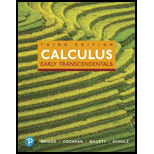
Explain why or why not Determine whether the following statements are true and give an explanation or counterexample.
- a. The variable y = t + 1 doubles in value whenever t increases by 1 unit.
- b. The function y = Ae0.1t increases by 10% when t increases by 1 unit.
- c. ln xy = (ln x)(ln y).
- d. sinh (lnx)=x2−12x.
a.
To explain: Whether the statement “The variable y=t+1 doubles in value whenever t increases by 1 unit” is true or false.
Explanation of Solution
Suppose t=2, the value of y becomes,
y=2+1=3
If t is increased by 1 unit, t=3,
y=2+1=3
Hence, the value of y will not be doubled whenever t increases by 1 unit.
Therefore, the given statement is false.
b.
To explain: Whether the statement “The function y=Ae0.1t increases by 10% when t increases by 1 unit” is true or false.
Explanation of Solution
Suppose t=2, then
y1=Ae0.1×2=Ae0.2≈1.221A
If t is increased by 1 unit, that is t=3,
y2=Ae0.1×3=Ae0.3≈1.35A
Hence, the percentage increase of both values is approximately 10.57%.
Therefore, the given statement is false.
c.
To explain: Whether the statement lnxy=(lnx)(lny) is true or false.
Explanation of Solution
Consider the equation lnxy=(lnx)(lny).
Suppose x=2 and y=3.
Compute the value of lnxy.
ln(2×3)=ln6≈1.791
Compute the value of (lnx)(lny).
(lnx)(lny)=(ln2)(ln3)=0.693×1.09≈0.762
Clearly, ln6≠(ln2)(ln3).
Therefore, the given statement is false.
d.
To explain: Whether the statement sinh(lnx)=x2−12x is true or false.
Explanation of Solution
Compute sinh(lnx) as follows.
sinh(lnx)=elnx−e−lnx2 [∵sinhx=ex−e−x2]=elnx−elnx−12 [∵lnxa=alnx]=x−1x2 [∵elnx=x]=x2−12x
Hence, sinh(lnx)=x2−12x.
Therefore, the given statement is true.
Want to see more full solutions like this?
Chapter 7 Solutions
Calculus: Early Transcendentals (3rd Edition)
Additional Math Textbook Solutions
Algebra and Trigonometry (6th Edition)
Precalculus
Elementary Statistics
University Calculus: Early Transcendentals (4th Edition)
Elementary Statistics (13th Edition)
A Problem Solving Approach To Mathematics For Elementary School Teachers (13th Edition)
- I need help in ensuring that I explain it propleryy in the simplifest way as possiblearrow_forwardI need help making sure that I explain this part accutartly.arrow_forwardPlease help me with this question as I want to know how can I perform the partial fraction decompostion on this alebgric equation to find the time-domain of y(t)arrow_forward
- Please help me with this question as I want to know how can I perform the partial fraction on this alebgric equation to find the time-domain of y(t)arrow_forwardEvaluate F³ - dr where ♬ = (4z, -4y, x), and C' is given by (t) = (sin(t), t, cos(t)), 0≤t≤ñ .arrow_forwardMid-Term Review Find the formula for (f + g)(x). f(x) = x² - 10x + 25 and g(x) = x² - 10x + 24 (f + g) (x) = [ 2 ]x² X + DELL Skip Sarrow_forward
- Calculus III May I please have some elaborations on Example 2 part a? Thank you.arrow_forward1. A bicyclist is riding their bike along the Chicago Lakefront Trail. The velocity (in feet per second) of the bicyclist is recorded below. Use (a) Simpson's Rule, and (b) the Trapezoidal Rule to estimate the total distance the bicyclist traveled during the 8-second period. t 0 2 4 6 8 V 10 15 12 10 16 2. Find the midpoint rule approximation for (a) n = 4 +5 x²dx using n subintervals. 1° 2 (b) n = 8 36 32 28 36 32 28 24 24 20 20 16 16 12 8- 4 1 2 3 4 5 6 12 8 4 1 2 3 4 5 6arrow_forward= 5 37 A 4 8 0.5 06 9arrow_forward

 Linear Algebra: A Modern IntroductionAlgebraISBN:9781285463247Author:David PoolePublisher:Cengage LearningAlgebra & Trigonometry with Analytic GeometryAlgebraISBN:9781133382119Author:SwokowskiPublisher:Cengage
Linear Algebra: A Modern IntroductionAlgebraISBN:9781285463247Author:David PoolePublisher:Cengage LearningAlgebra & Trigonometry with Analytic GeometryAlgebraISBN:9781133382119Author:SwokowskiPublisher:Cengage College Algebra (MindTap Course List)AlgebraISBN:9781305652231Author:R. David Gustafson, Jeff HughesPublisher:Cengage Learning
College Algebra (MindTap Course List)AlgebraISBN:9781305652231Author:R. David Gustafson, Jeff HughesPublisher:Cengage Learning College AlgebraAlgebraISBN:9781305115545Author:James Stewart, Lothar Redlin, Saleem WatsonPublisher:Cengage Learning
College AlgebraAlgebraISBN:9781305115545Author:James Stewart, Lothar Redlin, Saleem WatsonPublisher:Cengage Learning Algebra: Structure And Method, Book 1AlgebraISBN:9780395977224Author:Richard G. Brown, Mary P. Dolciani, Robert H. Sorgenfrey, William L. ColePublisher:McDougal Littell
Algebra: Structure And Method, Book 1AlgebraISBN:9780395977224Author:Richard G. Brown, Mary P. Dolciani, Robert H. Sorgenfrey, William L. ColePublisher:McDougal Littell





